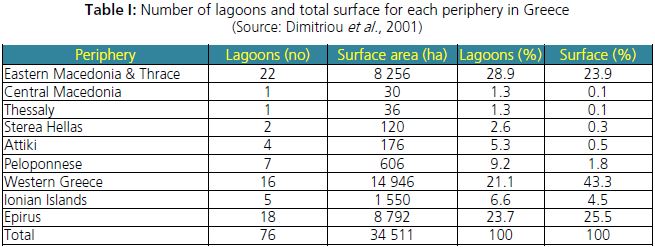5. GREECE
This country report was written by Sofia Reizopolou, Hellenic Centre for Marine Research, Anavyssos, Greece.
5.1 Introduction
Coastal lagoons in Greece are defined as enclosed water bodies situated in coastal locations, with a wide range of temperatures and salinities, separated from the sea by narrow barriers with openings allowing limited water exchange.
Almost all lagoons in Greece operate as extensive fish farms and, except for a few cases, they belong to the state and are leased to local fishing cooperatives. Fisheries exploitation is implemented through the use of nets and barrier fish traps. The number of lagoons and total surface for each periphery1 in Greece is shown in Table I. It is estimated that in a total area of about 34 00 ha, including more than 76 lagoons (30 in the Aegean and 46 in the Ionian coast), about 700–1 600 tonnes of fish from fishing and extensive aquaculture activities are landed annually (Dimitriou et al., 2001; Tsihrintzis et al., 2007). The mean annual production varies significantly depending on the size of the lagoon, where differences in fish catch composition are also observed.
Most lagoons in Greece are managed by regional authorities; they are mostly leased to fishing cooperatives and in a few cases to private companies, however the priority is given to local fishers.
Table I: Number of lagoons and total surface for each periphery in Greece
(Source: Dimitriou et al., 2001)
